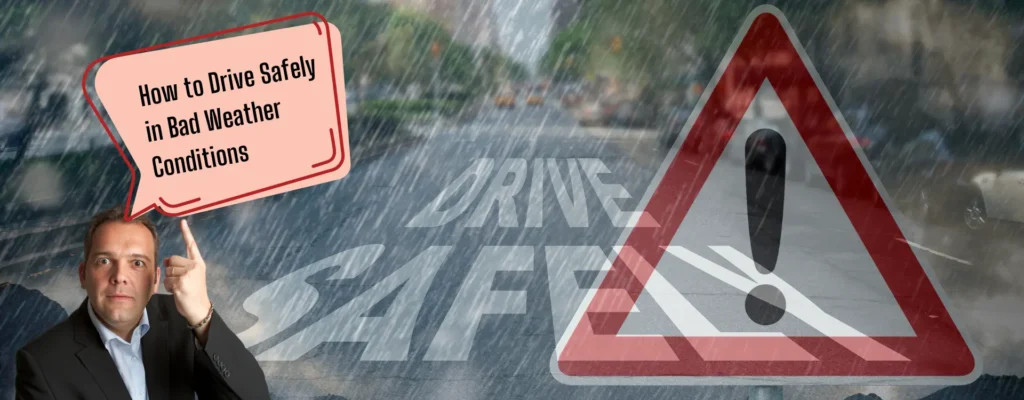
Driving in bad weather conditions can be a daunting task, especially in a state like California, where the weather can change rapidly. From sudden rainstorms to foggy mornings, it’s crucial to know how to handle your vehicle safely.
Here are some tips and best practices to ensure safe driving in bad weather conditions.
IN NEED OF A POST- ACCIDENT CAR REPAIR?
Understanding the Risks of Bad Weather
California’s diverse weather conditions present unique challenges for drivers. Whether you’re dealing with heavy rain, fog, or even unexpected snow in higher elevations, understanding when you need to take extra caution can help you prepare adequately.
Wet roads can lead to hydroplaning, fog can drastically reduce visibility, and icy patches can be treacherous. Being aware of these dangers is the first step in ensuring you can drive safely in bad weather.
Prepare Your Vehicle for Poor Visibility and Roads
Before setting, ensure your vehicle is well-maintained and ready to handle adverse weather. Here are some essential checks:
- Tires: Ensure your tires have adequate tread depth and are properly inflated. Bald tires can significantly increase the risk of skidding.
- Brakes: Have your brakes checked regularly. Good brakes are essential for stopping safely on wet or slippery roads.
- Wipers and Lights: Ensure your windshield wipers are in good condition and your lights are working correctly. Visibility is critical in severe weather.
- Fluids: Check your vehicle’s fluid levels, including brake fluid, oil, and windshield washer fluid.
Driving in Heavy Rain and Inclement Weather
Heavy rain can reduce visibility and traction. Here are some tips for handling your vehicle in rainy conditions and how to drive safely in bad weather:
- Slow Down: Reduce your speed to maintain better control of your vehicle.
- Increase Following Distance: Leave more space between you and the car in front of you to allow for longer stopping distances.
- Use Headlights: Turn on your headlights to improve visibility, but avoid using high beams as they can reflect off the rain and decrease visibility.
- Avoid Standing Water: Driving through standing water can cause hydroplaning. If you do hydroplane, ease off the gas and steer straight until you regain traction.
Tips for Driving Safely in Foggy Conditions
Fog can severely limit your visibility, making it one of the most dangerous weather conditions to drive in. To drive safely in poor weather like fog, follow these guidelines:
- Use Fog Lights: If your vehicle is equipped with fog lights, use them to enhance visibility.
- Slow Down: Reduce your speed to give yourself more time to react to obstacles and oncoming traffic.
- Use the Right Lane: Stick to the right lane and use road markers to guide you.
- Avoid High Beams: High beams can reflect off the fog and impair your vision further.
Handling Snow and Ice
While snow and ice are rare in most parts of California, they can still present challenges in higher elevations or during unexpected weather changes. Here’s how to drive safely in bad weather involving snow and ice:
- Use Snow Tires or Chains: If you live in an area prone to snow, consider using snow tires or chains for better traction.
- Accelerate and Decelerate Slowly: Gradual movements can help prevent skidding.
- Increase Following Distance: Leave a larger gap between your car and the vehicle ahead to account for longer stopping distances.
- Know How to Correct a Skid: If your car begins to skid, steer in the direction you want to go and avoid slamming on the brakes.
General Tips for Safe Driving in Bad Weather Conditions
Regardless of the specific weather events, these tips for driving in bad conditions can help you stay safe when you’re behind the wheel:
- Stay Alert: Pay close attention to your surroundings and be ready to react quickly.
- Avoid Distractions: Keep your focus on the road and avoid using your phone or other distractions.
- Plan Ahead: Check the weather forecast before you leave and plan your route accordingly. If possible, delay your trip until conditions improve.
- Emergency Kit: Keep an emergency kit in your car, including items like blankets, a flashlight, snacks, and a first-aid kit.
Knowing When to Stay Off the Road
Sometimes, the best way to ensure safe driving in bad weather is to avoid driving altogether. If the weather conditions are too severe, consider postponing your trip or finding alternative transportation. Overpasses and bridges can be particularly dangerous because they freeze before other surfaces and are prone to becoming slippery.
What to Do If You’re in an Accident
Despite taking all the necessary precautions, accidents can still happen. If you find yourself in a collision, follow these steps:
- Stay Calm: Keep calm and assess the situation. Ensure everyone is safe and call for emergency assistance if needed.
- Move to a Safe Location: If possible, move your vehicle to a safe location away from traffic.
- Exchange Information: Exchange contact and insurance information with the other driver(s) involved.
- Document the Scene: Take photos of the scene, including any damages and relevant road conditions.
Keep Safe from Car Accidents in California. But If You’re in a Bind, Find a Reliable Body Shop Through Collision Connect.
Understanding these common causes of car accidents can help you drive safely in bad weather. If you do find yourself involved in a traffic accident, know that you have the right to file a personal injury claim for serious injuries. Other than that, finding a reliable body shop is crucial for repairing your vehicle and getting back on the road safely.
Visit Collision Connect to find a trusted collision repair center near you. With our network of certified collision repair centers, you can ensure your vehicle is in good hands. Contact us.
IN NEED OF A POST- ACCIDENT CAR REPAIR?